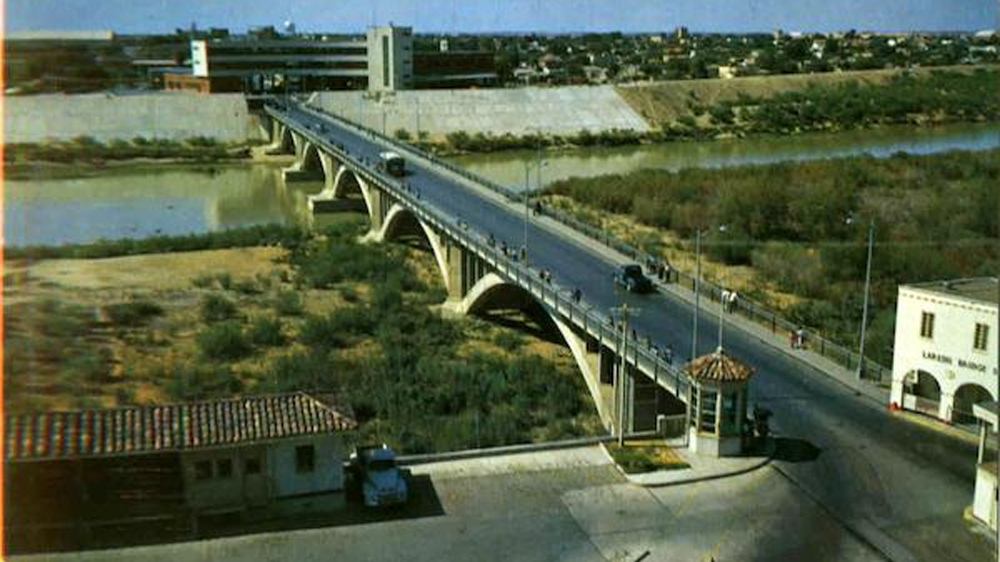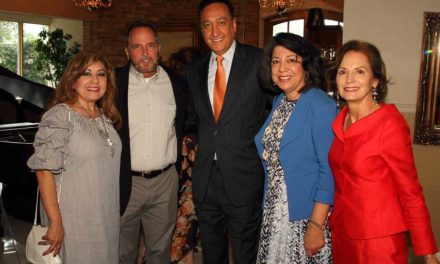Vivir en la frontera is an unforgettable experience.
Hay muchos momentos inolvidables that are embedded
In our hearts and souls.
Es muy bonito compartir los buenos momentos with our
Neighbors across the Río Grande.
We were like a family porque el río no nos dividia.
I was born at home y cinco cuadras from the Río Grande in the 1940s,
In the Barrio El Azteca in Laredo, Texas en un ambiente muy Mexicano.
Mis padres eran de México and spoke only Spanish.
Also all the people spoke the same language and muchos hablaban TexMex.
También todos escuchaban Mexican music and novelas on their radios.
My encounter con la idioma de Inglés and a different culture occurred when
I attended las escuelitas del barrio y my nickname was “prietito.”
I am brown and orgulloso to be mestizo.
Mi sangre is Spanish and Indigenous.
I felt proud aprender a second language, to become bilingual.
En la escuela Católica de San Agustín, we spoke English in front of the nuns,
Pero seguíamos hablando in Spanish entre la raza.
Also, we had family, friends and now classmates que vivian al otro lado, en Nuevo Laredo.
To cross the Río Grande was as common como cruzar una calle en el barrio.
Nunca vimos el río como una división, but more of a symbol that united us.
A veces íbamos a Misa en Nuevo Laredo and there was no difference in the liturgy.
During Christmas, celebrabamos con Las Posadas, Los Pastores, and the dances of the Matachines.
Y on Holy Thursday we went to visit seite iglesias, a deeply religious Mexican tradition.
All of these religious and cultural activities se celebraban en ambos lados of the Rio Grande.
Tradiciones de nuestra herencia that are very important.
También, we went to the Mexican market para comprar meat and mandado cada dos semanas.
And on special events, íbamos a un restaurant and enjoy Mexican food,
just like Mama cocinaba, but much tastier like mole de olla, frijoles a la charra,
And menudo Veracruzano.
Además Mama also cooked tamales y buñuelos for special days.
Y Papa prepared his favorite Tepache.
In downtown Laredo, yo aprendi a bi-cultural history lesson with the names of the streets:
Zaragoza Street (General Ignacio Zaragoza), Grant Street (General Ulysses S. Grant)
Iturbide Street (Presidente Agustín de Iturbide), Hidalgo Street (Padre Miguel Hidalgo)
La calle Lincoln (President Abraham Lincoln), la calle Washington (President George Washington)
Farragut Street (Admiral David Farragut), Matamoros Street (Padre Mariano Matamoros),
Victoria Street (Presidente Guadalupe Victoria), and Houston Street (Senator Sam Houston).
We lived on Iturbide Street y luego on Zaragoza Street por muchos años
Vivir en la frontera, the Mexican and American culture surrounded us and embraced us.
Pan de dulce and sweet bread were available at the Aguila Bakery, Dandy Bakery, El Gallo Bakery,
Charro Panadería, Colonia Bakery, Richter Baking Co., Superior Bakery, y La Perla Bakery.
Y cuando estabamos en Nuevo Laredo we also went to their El Gallo Bakery.
To watch Mexican and American movies, teníamos El Cine Azteca three blocks from the house.
Y a veces we went to the Cine Alameda across the river.
Para ver only English speaking movies, we had the Plaza and Tivoli theaters.
Nos gustaba ver a Pedro Infante, Dolores del Río, Jorge Negrete, María Félix, Luis Aguilar,
La Tongolele, Sara García, Flor Silvestre, David Silva, Libertad Lamarque, and many more.
As well as James Stewart, John Wayne, Shirley MacLaine, Kim Novak, Marlon Brando,
Clark Gable, Elizabeth Taylor, Marilyn Monroe y más artistas.
Y una vez al año íbamos a ver al comedian and movie actor Mario Moreno Cantinflas
Perform at the bullring in Nuevo Laredo.
Durante el 22 de febrero, we celebrated George Washington’s birthday with
A big parade and many festivities y la gente del otro lado came to join us in the celebration.
And all these events started cuando un niño de Laredo y una niña de Nuevo Laredo
Se unian en el medio of the International Bridge para darce un cariñoso abrazo,
A symbolic gesture of friendship entre dos paises.
Y la gente de Laredo celebrated Mexican Independence and the Cinco de Mayo
With the same patriotic fervor y amistad.
In the Barrio El Azteca así como en Nuevo Laredo se prácticaba mucho el curanderismo.
El curanderismo is an integral component de nuestra cultura en ambos lados del río.
Mi abuelo y abuela de Laredo y mi tía de Nuevo Laredo were successful healers.
They used herbs para curar el cólico, susto, empacho, the evil eye, bruises, and pains.
Sometimes, una barrida with a bundle of herbs y una oración era necesario.
No ibamos con el doctor unless one was seriously ill and needed medical attention.
And to discover and explore new horizons and neologisms y un mundo diferente afuera
Del Barrio El Azteca teníamos en Laredo two bookstores where I bought magazines,
Comics, newspapers, and books.
One of these bookstores sold newspapers en Español y allí le compraba a Mamá two
Newspapers from Mexico.
Para satisfacer nuestro deseos para comprar libros, revistas, and comics in Spanish íbamos a
La Papelería Calderón en Nuevo Laredo.
Aunque ya no vivo en la frontera, however, when I feel nostalgic about the Barrio El Azteca
And about Nuevo Laredo, I remember lo que mi santa madre me decia, “El recordar es vivir,”
Y es muy cierto porque living on the border is a very special and unique experience
Que nunca se olvida.
It is living an ancestral heritage of two cultures, dos idiomas, and two histories that unite us.
Photo Caption: A view of the Laredo International Bridge looking south towards Nuevo Laredo, Tamaulipas, Mexico., and this was the only international bridge when I was growing up. Our house at 801 Zaragoza Street was located four blocks from the international bridge. And, St. Augustine School was located only two blocks from the international bridge.










